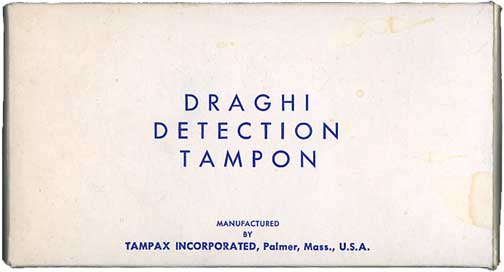Read ads for Pond
medical tampons,
1910, U.S.A. See a stock
certificate (1916) for probably a
company that made medical tampons used in World War I. Read a
meaning of the
word tampon from a 1900 nurses' dictionary
from the U.K. Read also a
discussion of the word with examples.
Medical tampons mentioned
in newspapers, U.S.A., 1894-1921


|
Draghi Detection
Tampon (submitted by the patient to
a doctor or
laboratory for the detection of cervical
cancer)
Tampax Inc. (U.S.A., date?)
Tampons have plugged holes
in the body probably for thousands
of years. They absorbed bodily
fluids - pus for example - and
carried medicine to the cavities.
The Draghi tampon - Andre Draghi
invented it - allowed women to insert it
themselves into the vagina to
pick up cells, which a
laboratory or physician then
examined for abnormalities
like cancer. It spared
women and doctors the time
necessary to accomplish the same
thing in the doctor's office.
From the patent
(1959):
This invention relates to a
tampon for detection of
cancer [all
color and bold face added]. More
particularly it relates to a
tampon as a means for mass
screening and detection of
cancer of the pelvic region.
The frequency of advanced
cancer of the pelvic region
presents to the medical
profession a disturbing picture.
One author states that only a
relatively small percentage of
the cases of cancer of the
cervix is detected in the early
stage of the disease. This is in
spite of the various methods to
detect cancer of the cervix
which have been developed and
are being used by gynecologists
today. Among the practical
barriers to prompt diagnosis is
the inability
and the reluctance of many
women to present themselves
periodically to a physician
for a gynecological
examination whereby early
evidence of cancer may be
detected; this inability and
reluctance is a direct cause
of the high percentage of
advanced cancer which occurs
or develops in the pelvic
region and particularly in the
region of the cervix uteri.
Furthermore the protracted
gynecological examination of the
patient which is necessary to
obtain full diognostic
information, is time consuming
for the physician and nurse and
accordingly any such routine
periodical examination may be
prohibitively expensive for the
patient, and the medical
organization undertaking it.
Complete diagnosis to determine
whether and to what extent one
has cancer must require a
thorough gynecological and
pelvic examination and biopsy.
Preliminiary diagnosis to
determine if there are present
any indicia of cancer however,
may be asserted by taking a
sample of cells which are
present in the cervical canal
and the vagina and the
subsequent microscopic analysis
of these cells. While a thorough
gynecological examination and
biopsy should be performed in
those cases in which the
preliminary diagnosis indicates
cancer, the preliminary
diagnosis can serve to screen
many women and thus initiate the
early treatment of those who
have indications of cancer.
It is therefore an object of
this invention to provide a
means for mass
screening for cytological
detection of carcinomas of
the pelvic region.
A further object of this
invention is to provide through
the cooperation of the patient
herself, an accurate,
inexpensive means by which cells
present in the pelvic region can
be collected and thus screen
large numbers of women thereby
reducing the percentage of cases
having advanced pelvic cancer.
It seems to me that Tampax was
probably not
the
only maker of the tampon but
I have no proof of this.
Dr. Robert Dickinson wrote in a
famous
report that medical (not
menstrual) tampons "used to pay
the office rent," something
to think about during a battle to
improve health care. By the way,
the doctor wrote that of women who
used tampons in 1942, 37 percent made their
own. The paper insert for an
early
commercial American menstrual
tampon mentions this
practice and the long-standing use
in Europe of homemade tampons
among actresses.
Tampax, the first menstrual
tampon with an applicator,
has been the number one tampon in
America for decades and quite
possibly the first
commercial menstrual tampon in
Europe.
Read ads for Pond medical tampons,
1910, U.S.A. See a stock
certificate (1916) for
probably a company that made
medical tampons used in World War I.
Read a meaning
of the word tampon from a 1900
nurses' dictionary from the U.K.
Read also a
discussion of the word with
examples.
Medical
tampons mentioned in
newspapers, U.S.A., 1894-1921
Tampon
directory.
I thank
Procter & Gamble, current
owner of Tampax tampons, for
donating the box!
|
Below:
The front of the cardboard box.
The other sides are blank. I
guess Tambrands didn't feel
doctors had to be seduced by color
and fancy graphics.
|

|
NEXT | the tampon - box
© 2009 Harry Finley. It is illegal to
reproduce or distribute any of the work on
this Web site
in any manner or medium without written
permission of the author. Please report
suspected
violations to hfinley@mum.org\
|